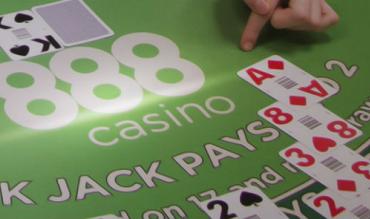The 3 most misplayed hands in Blackjack
Here you will learn how to play three hands that most blackjack player misplay because the correct basic strategy for them is not so intuitive.
12 VS DEALER 3
When a player holds a 9-3 (12) against a dealer 3 upcard, he is reluctant to hit for fear of drawing a 10 and busting, especially when the dealer is showing a “weak” upcard. In the case of 6-5 (11) vs a dealer 10, players are averse to double down (and double their bet) because they fear the dealer has a 10 in the hole and a 20. When being dealt an A-7, players feel comfortable standing on 18, believing that an 18 should be good enough to beat a dealer’s 9 upcard. However, by watching the video, you’ll learn the correct way to play these hands, and the justification for the proper, albeit not always apparent, correct basic Blackjack playing strategy for them.
Most of the basic playing strategy is logical to players. For example, players understand why they shouldn’t hit a 16 when the dealer shows a 6 upcard or why they should split 8s against a dealer’s 5 upcard. However, some of the basic strategy plays are not so intuitive, which is the reason why players misplay them. In this video, we’ll show you three non-intuitive basic strategy plays (which is the optimum way to play your hand when the only information you know is your hand and the dealer’s upcard), and provide some justification for the proper, albeit not always apparent, basic strategy.
There is a rule in blackjack that says you should never risk busting your hand when the dealer shows a weak upcard (weak meaning a 2 through 6 because the dealer could break with a one-card draw). That may be true for most stiff hands (meaning, a hard 12 through 16) but it’s not the case when you are holding a 12 against a 3. There are only four cards that could bust your 12 — a ten, jack, queen, or king. On the other hand, five cards will get you to 17–21 (a five, six, seven, eight, or nine). Therefore, more cards will get you into the safe 17–21 zone than will break you. The other factor that works in your favor is the dealer’s 3 upcard, which is not as weak as, say, a 4, 5, or 6 upcard (she will bust less with a 3 upcard compared to the 4, 5, or 6. The dealer’s bust-out rate is about 42% for with a 5 and 6 upcard and only 37% with a 3 upcard.). The bottom line is that you will win your hand a little more often by hitting than by standing on 12 against a dealer’s 3.
6-5 VS DEALER 10
When a player is dealt a 6-5 against a dealer’s 10 upcard, more often than not he will hesitate doubling down because he instinctively assumes the dealer has a pat 20 and doesn’t want to risk more money by doubling. However, did you know that when you are initially dealt a two-card 11 (e.g., 6-5, 9-2, 7-4), you’ll make a 20 or 21 on a one card draw more often than the dealer will make a 20? When you double down, you’ll win about six times out of 11 (meaning you will win six times for every five time you lose); therefore, you can’t afford not to double down when you are a 6-5 favorite to win.
A-7 VS DEALER 9
Most players stand with an A-7 (soft 18) against a dealer’s 9 upcard, reasoning that an 18 is good enough to beat the dealer. But did you know if you play an entire lifetime of blackjack and are dealt a pat 18 on every single hand, you’d die a small loser! (that is because your overall expectation is negative when you stand on 18). That’s the grim truth. And that dealer’s 9 upcard doesn’t exactly help your chances any. However, the ace in your hand gives you some flexibility. If you stand, you’ll win about eight times out of twenty. If you hit all the way to soft 19, a hard 17, or bust, (meaning you hit until you achieve one of the following: a soft 19, hard 17, or you bust or exceed 21), you’ll win nine out of twenty. So take your choice ... eight wins by standing or nine wins by hitting. The correct play is to hit the soft 18.

